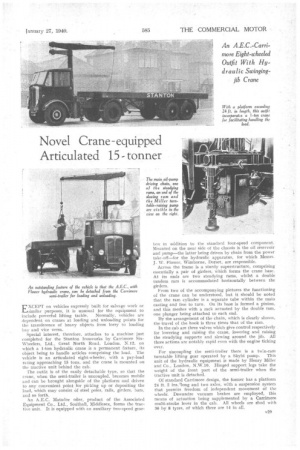Novel Crane-equipped Articulated 15tonner
Page 31

If you've noticed an error in this article please click here to report it so we can fix it.
EXCEPT on vehicles expressly built for salvage work or .1---Asimilar purposes, it is unusual for the equipment to
include powerful lifting tackle. Normally, vehicles are dependent on cranes at loading and unloading points for the transference of heavy objects from lorry to loading bay and vice versa.
Special interest, therefore, attaches to a machine just completed for the Stanton Ironworks by Carrimore SixWheelers, Ltd., Great North Road, London, N.12, on which a 1-ton hydraulic crane is a permanent fixture, its object being to handle articles comprising the load. The vehicle is an articulated eight-wheeler, with a pay-load rating approaching 15 tons, and the crane is mounted on the tractive unit behind the cab.
The outfit is of the easily detachable type, so that the crane, when the semi-trailer is uncoupled, becomes mobile and can be brought alongside of the platform and driven to any convenient point for picking up or depositing the load, which may consist of steel poles, rails, girders, bars, and so forth.
An A.E.C. Matador oiler, product of the Associated Equipment Co., Ltd,, Southall, Middlesex, forms the tractive unit. It is equipped with an auxiliary two-speed gear
box in addition to the standard four-speed component. Mounted on the near side of the chassis is the oil reservoir and pump—the latter being driven by chain from the power take-off—for the hydraulic apparatus, for which Messrs. J. W. Flower, Wimborne, Dorset, are responsible.
Across the frame is a sturdy superstructure, comprising essentially a pair of girders, which forms the crane base. At its ends are two steadying rams, whilst a double tandem ram is accommodated horizontally between the girders.
From two of the accompanying pictures the functioning of the crane can be understood, but it should be noted that the ram cylinder is a separate tube within the main casting and free to turn. On its base is formed a pinion, and this meshes with a rack actuated by the double ram, one plunger being attached to each end.
By the arrangement of the chain, which is clearly shown, the travel of the hook is three times that of the ram.
In the cab are three valves which give control respectively for lowering and raising the crane, lowering and raising the steadying supports and slewing around the jib. All three actions are notably rapid even with the engine ticking over.
For uncoupling the semi-trailer there is a twin-ram turntable lifting gear operated by a Skyhi pump. This unit of the hydraulic equipment is made by Henry Miller and Co., London, N.W.10. Hinged support legs take the weight of the front part of the semi-trailer when the tractive unit is detached.
Of standard Carrimore design, the former has a platform 24 ft. 2 ins.1ong and two axles, with a suspension system that permits freedom of independent movement of the wheels. Dewandre vacuum brakes are employed, this means of actuation being supplemented by a Carritnore multi-stroke lever in the cab. All wheels are shod with 36 by 8 tyres, of which there are 14 in all.




















































